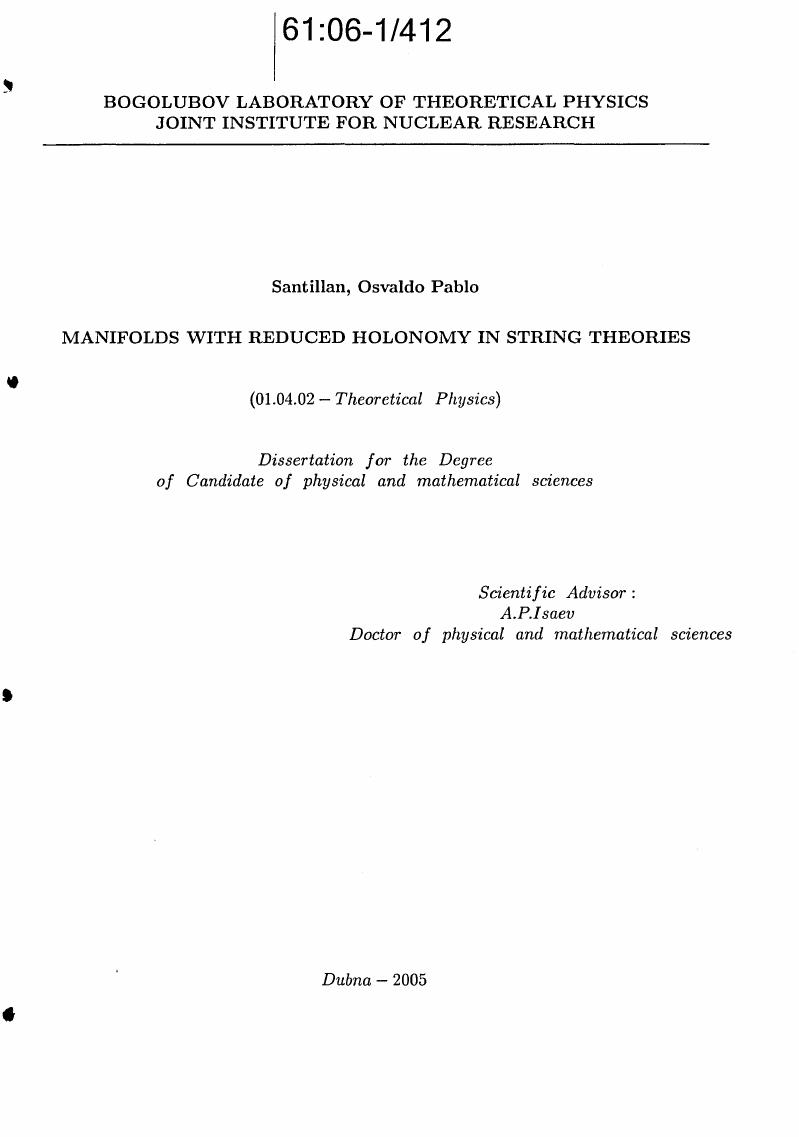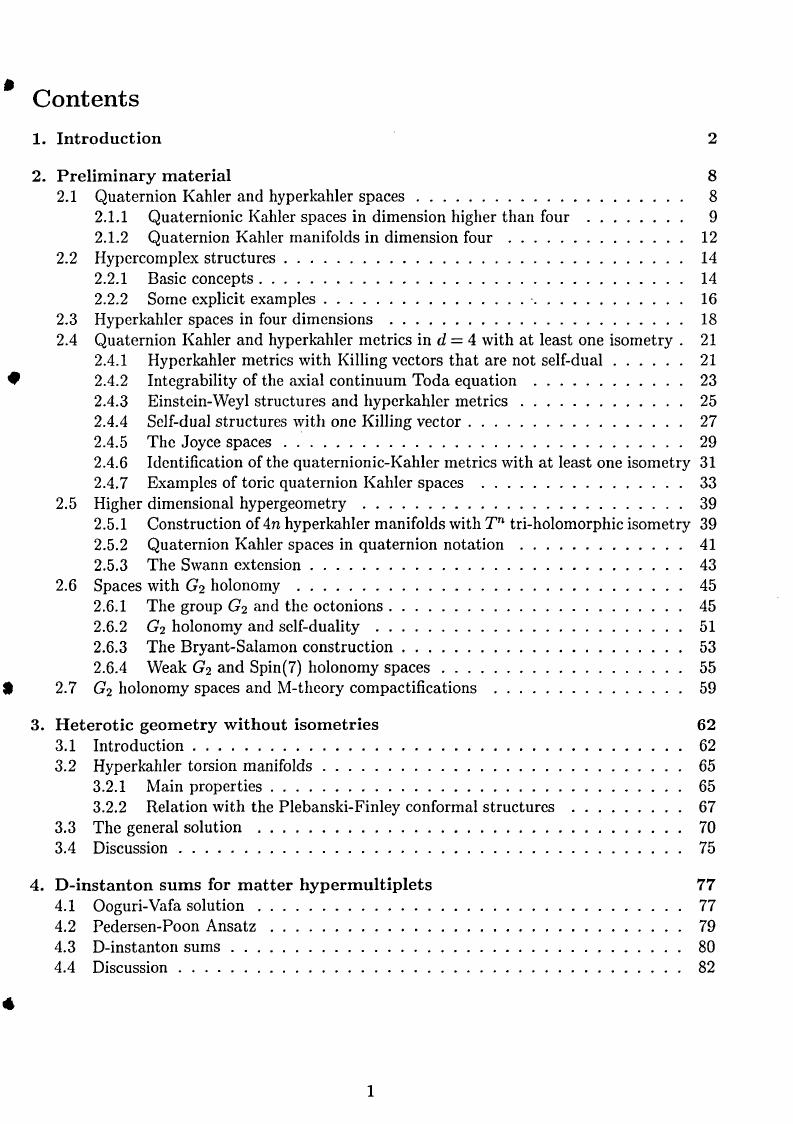Многообразия с редуцированной голономией в суперструнных теориях

- Автор:
Сантиллан Освальдо Пабло
- Шифр специальности:
01.04.02
- Научная степень:
Кандидатская
- Год защиты:
2005
- Место защиты:
Дубна
- Количество страниц:
105 с.
Стоимость:
700 р.499 руб.


Contents
1. Introduction
2. Preliminary material
2.1 Quaternion Kahler and hyperkahler spaces
2.1.1 Quaternionic Kahler spaces in dimension higher than four
2.1.2 Quaternion Kahler manifolds in dimension four
2.2 Hypercomplex structures
2.2.1 Basic concepts
2.2.2 Some explicit examples
2.3 Hyperkahler spaces in four dimensions
2.4 Quaternion Kahler and hyperkahler metrics in d = 4 with at least one isometry
2.4.1 Hyperkahler metrics with Killing vectors that are not self-dual
♦ 2.4.2 Intcgrability of the axial continuum Toda equation
2.4.3 Einstein-Weyl structures and hyperkahler metrics
2.4.4 Self-dual structures with one Killing vector
2.4.5 The Joyce spaces
2.4.6 Identification of the quaternionic-Kahler metrics with at least one isometry
2.4.7 Examples of toric quaternion Kahler spaces
2.5 Higher dimensional hypergeometry
2.5.1 Construction of 4n hyperkahler manifolds with Tn tri-holomorphic isometry
2.5.2 Quaternion Kahler spaces in quaternion notation
2.5.3 The Swann extension
2.6 Spaces with G2 holonomy
2.6.1 The group G2 and the octonions
2.6.2 6?2 holonomy and self-duality
2.6.3 The Bryant-Salamon construction
2.6.4 Weak G2 and Spin(7) holonomy spaces
S 2.7 (?2 holonomy spaces and M-thcory compactifications
3. Heterotic geometry without isometries
3.1 Introduction
3.2 Hyperkahler torsion manifolds
3.2.1 Main properties
3.2.2 Relation with the Plebanski-Finley conformal structures
3.3 The general solution
3.4 Discussion
4. D-instanton sums for matter hypermultiplets
4.1 Ooguri-Vafa solution
4.2 Pedersen-Poon Ansatz
4.3 D-instanton sums
4.4 Discussion
5. Hyperkahler spaces with local triholomorphic U(l) x [/(1) isometry and supergravity solutions
5.1 Toric hyperkahler metrics of the Swann type
5.2 Supergravity solutions related to hyperkahler manifolds
6. G2 toric metrics and supergravity backgrounds
7. Conclusion
A Supersymmetric sigma models
* 1. Introduction
The Weinberg-Salam theory is a quantum field theory that explain successfully two of the four known interactions of the nature, the electromagnetic and the weak interactions. The strong interaction is widely believed to be described by quantum chromodynamic, which is a theory that fits successfully with deep inelastic lepton nucleeon scattering data. The remaining interaction, namely gravity, is believed to be described at classical level, by Einstein’s General Theory of Relativity. The Weinberg-Salam model plus quantum chromodynamics and Einstein gravity are incompatible for small distances or, which is the same, for high energy scales of the order of the Planck mass Mpi sa 1019 GeV. The physics at this scale of energy is not known yet.
Superstring theory attempts to explain the physical phenomena at this scale. The present work deal with applications of manifolds with reduced holonomy to supersymmetric and superstring theories. The problem of classifying the possible holonomy groups for Riemannian and pseudo Riemannian spaces was possed by Cartan in [2] and partially solved by Berger in [1], who presented a list of all the possible holonomy groups. Two special cases of this list, relevant for are purposes, are the quaternion Kahler and hyperkahler spaces. By definition these spaces are 4n-dimensional with holonomies included in the Lie groups Sp(n) x Sp( 1) and Sp(n), respectively. Some of their properties has been investigated in [3], [4], and [5] but they are not completely classified at the present.
It is convenient to explain what we mean when we speak about an holonomy group. Consider a field ip defined over a given point x on a n-dimensional manifold M, and let us parallel transport it around a given closed curve 7. In general the result of this transport will be a new field ip7 at p that is different than the original one ip. Let us introduce the transformation matrix H1 by
ipy = Hyip. (1.1)
If we take into account all the possible closed (^-piecewise curves passing through the point p it can be shown that the corresponding matrices H(p) form a group. This is the full holonomy group of the manifold at the point x and is a subgroup of the orthogonal group 0(Tp). If 0 instead we consider only curves 7 that are contractible to a point, we will obtain the so called restricted holonomy group H°(p) which is a subgroup of SO(Tp).
If we change from the point p to a point q and fix some Crl-piecewise curve 0 connecting both point we will have the transformation
H(q) = A(0)H(p)A(0)~l
and the same for H°(p). The matrix A belongs to the holonomy group H(p) and it follows that H(p) and H{q) are isomorphic. Therefore we can talk about holonomy groups without reference to some specific point p. An space is orientable if and only if the holonomy group is in SO(n). If the fundamental group ni(M) = 0, then H — H°. We recall that there exist non simply connected manifolds for which 7Ti (M) = 0, an example is the flat tori [6].
From the definition of the curvature tensor Rabcd [7] it is known the variation of ip under an infinitesimal closed curve 7 is given by
Sip = Gab5Aabip. (1.2)
® Here Aab is the area spanned by the curve 7 and Gab — Rabc
which gives
е'в _ ( cos(aA) sin(aA) / eB
— sin(a^) cos(a^) ) I ec
e'D ^ = ( C0S(a^) ~S'm(aA) W eD e'E ) sin(ou) cos(0,4) )eE
This mean that it is induced a rotation on the planes (eE, ec) and (eE, ce) with angles and -aa- Therefore the generator of this group action is
Jbc ~ Jde (2.197)
being Jbc and JEE the anti-hermitian rotation generators. In similar manner the generators for the transformation corresponding to can be obtained, the result is
-^(Jbc + Jde — 2Jfg)- (2.198)
The indices run from 1 to 7 and therefore we have 14 generators. It is also direct to check that
they close under commutation and therefore they are a subalgcbra of 50(7). This is the G2
subalgebra. If we add
Jbc + Jde + Jfg (2.199)
it can be seen that (2.197), (2.198) and (2.199) generate 50(7) [165].
As we recalled before, the associator
(a, b, c) — (ab)c - a(bc) (2.200)
for three arbitrary octonions a, b and c is not zero and therefore the algebra is non associative. But (2.200) is fully antisymmetric and therefore the octonion algebra is alternating. Is therefore obvious that
(ei; Ci, Cj)
which implies that
^aed^bed — 6da£,. (2.201)
The octonions also obey the Moufang identity [121]
(xa)(xb) = x(ab)x. (2.202)
which implies that
CpaqCqbsCscp “ Oca£>c* (2.203)
Let us define the dual octonion constants
cm = ^eaMe^cefg, (2.204)
which are explicitly
C4567 = C2374 = C1357 — C1276 = C2356 = <4245 = C1346 — 1. (2.205)
It can be checked the fundamental identity
Cabcd — {fibc^ad ^ac^bd'} T ^-ate^'ede* (2.206)
Рекомендуемые диссертации данного раздела
| Название работы | Автор | Дата защиты |
|---|---|---|
| Квазиклассическое описание процессов динамического туннелирования в многомерной квантовой механике | Панин, Александр Григорьевич | 2010 |
| Фазовые переходы в калибровочных теориях и космология | Гончаров, Александр Сергеевич | 1984 |
| Теория возмущений высокого порядка и свойства некоторых квантово-механических систем | Иванов, Игорь Анатольевич | 2003 |